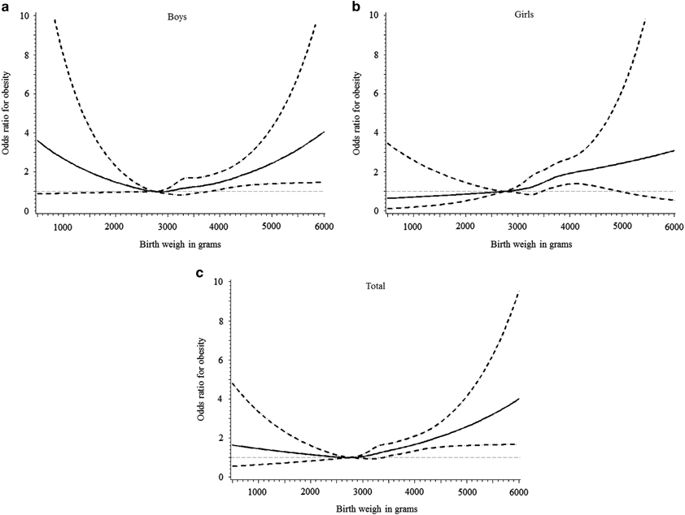International Journal of Obesity Supplements Pub Date : 2015-12-08 , DOI: 10.1038/ijosup.2015.23 Y Qiao 1 , J Ma 2 , Y Wang 2 , W Li 2 , P T Katzmarzyk 3 , J-P Chaput 4 , M Fogelholm 5 , W D Johnson 3 , R Kuriyan 6 , A Kurpad 6 , E V Lambert 7 , C Maher 8 , J Maia 9 , V Matsudo 10 , T Olds 8 , V Onywera 11 , O L Sarmiento 12 , M Standage 13 , M S Tremblay 4 , C Tudor-Locke 14 , T S Church 3 , P Zhao 2 , G Hu 3 ,

|
OBJECTIVES:
Few studies have investigated the association between the full range of birth weight and the risk of childhood obesity in high-, middle- and low-income countries. The aim of the present study is to assess the association between different levels of birth weight and the risk of obesity among children aged 9–11 years in 12 countries.
METHODS:
A multinational, cross-sectional study of 5141 children aged 9–11 years was conducted in 12 countries. Height and weight were obtained using standardized methods. Time spent in moderate-to-vigorous physical activity (MVPA), sedentary and sleeping were objectively measured using 24-h, waist-worn accelerometer (Actigraph GT3X+) monitored for 7 days. Birth weight and other factors (regions, parental education, maternal history of gestational diabetes, children age, gender, breast feeding, gestational age, unhealthy diet scores and healthy diet scores) were collected by parental and children’s questionnaires. Multilevel modeling was used to account for the nested nature of the data.
RESULTS:
The overall prevalence of obesity (BMI z-score>+2 s.d.) was 15.4% for boys and 10.0% for girls. There was a positive association between birth weight and BMI z-scores. The multivariable-adjusted odds ratios (ORs) of childhood obesity were significantly higher among children whose birth weights were 3500–3999 g (OR 1.45; 95% confidence interval (CI): 1.10–1.92), and >4000 g (OR 2.08; 95% CI: 1.47–2.93), compared with the reference group (2500–2999 g). The positive association between birth weight and the odds of childhood obesity was seen in girls, whereas a U-shaped association appeared in boys.
CONCLUSIONS:
High levels of birth weight, defined as birth weight ⩾3500 g, were associated with increased odds of obesity among 9–11-year-old children in 12 countries. However, sex differences in the association between birth weight and the risk of obesity need to be considered when planning interventions to reduce childhood obesity.
中文翻译:

出生体重和儿童肥胖:一项 12 个国家的研究
目标:
很少有研究调查高收入、中等收入和低收入国家的全部出生体重与儿童肥胖风险之间的关联。本研究的目的是评估 12 个国家 9-11 岁儿童不同出生体重水平与肥胖风险之间的关联。
方法:
对 12 个国家的 5141 名 9-11 岁儿童进行了一项跨国横断面研究。身高和体重是使用标准化方法获得的。使用腰部佩戴的加速度计 (Actigraph GT3X+) 连续 7 天监测 24 小时,客观测量中度至剧烈体力活动 (MVPA)、久坐和睡眠所花费的时间。通过家长和儿童的问卷调查收集出生体重和其他因素(地区、父母文化程度、母亲妊娠糖尿病史、儿童年龄、性别、母乳喂养、孕周、不健康饮食评分和健康饮食评分)。使用多级建模来解释数据的嵌套性质。
结果:
男孩的总体肥胖患病率(BMI z得分>+2 sd)为 15.4%,女孩为 10.0%。出生体重和 BMI z值之间呈正相关。出生体重为 3500-3999 克(OR 1.45;95% 置信区间 (CI):1.10-1.92)和 >4000 克(OR 2.08;95% 置信区间 (CI):1.10-1.92)的儿童的儿童肥胖的多变量调整比值比 (OR) 显着较高。 95% CI:1.47–2.93),与参考组(2500–2999 g)相比。在女孩中观察到出生体重与儿童肥胖几率之间呈正相关,而在男孩中则出现 U 形相关。
结论:
在 12 个国家中,高出生体重(定义为出生体重⩾ 3500 克)与 9-11 岁儿童肥胖几率增加相关。然而,在规划减少儿童肥胖的干预措施时,需要考虑出生体重与肥胖风险之间关系的性别差异。











































 京公网安备 11010802027423号
京公网安备 11010802027423号